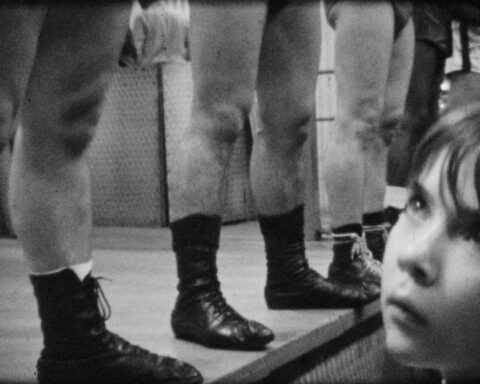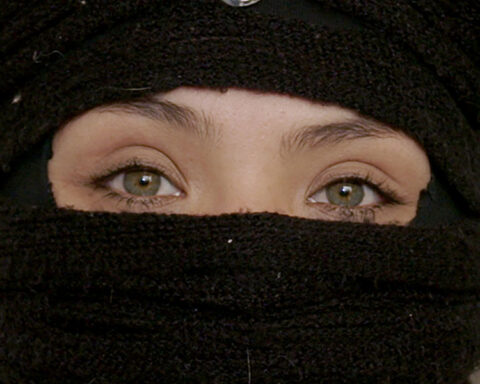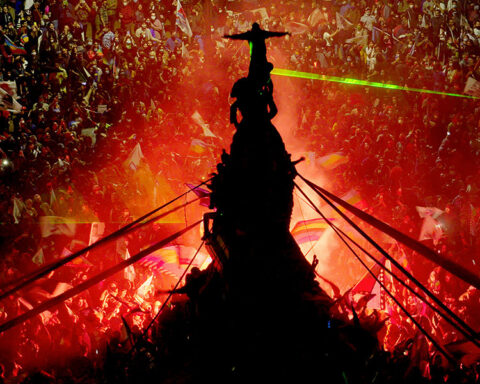POV’s editor Marc Glassman asked me: “Can you write something about your travels to European film festivals?” I’ve visited four festivals this autumn—it’s impossible. Too many films. But some impressions can lead a long way…
Sitting at a dinner table on the terrace of an old building in Lisbon, the old woman beside me has a tattooed number on her arm. She is now in her eighties and managed as a teenager to survive in Auschwitz. She also survived running around with her husband at the front during the Vietnam War filming The 17th Parallel. She was shot, and had to stay some weeks underground, together with some Vietnamese soldiers, recovering from wounds. Her eyes tell me that she has seen it all. The grand old lady is radiant: she is living film history. DocLisboa invited her in October for a master class and screened a retrospective of the films of her and her husband.
Marceline Loridan-Ivens worked for 30 years with her husband Joris Ivens. I “met” the late Joris in Témoins: Joris Ivens. In that film, the “Flying Dutchman” was sitting in an airport talking about when he made The Spanish Earth during the civil war, the precursor to the Second World War. He recalled driving with Ernest Hemingway to the fighting zone, his senses so alert that he could still remember a wet leaf stuck on the ground as they drove at high velocity in a car. They didn’t know if they would be back at the end of the day. He risked his life instead of going back to the Netherlands and signing protests against the Fascists.
Ivens’ commentary follows the images in several of his films. But in his exemplary …A Valparaíso, the narration was really written by Chris Marker, and the cinematography done by Patricio Guzmán. It was about life on the lower and higher ends of a city.
In A Tale of the Wind, Joris is the old man with the long white hair who sits on a chair alone in the desert sand. Waiting for the wind, he suddenly faints and falls head first to the ground. The camera is running in slow motion. Later in the film, Marceline uses another scene, where Joris walks away from the chair and out of the frame—a metaphor for his death.
Seventy-three-year-old Jørgen Leth was also invited for a DocLisboa master class and retrospective. Documentarian Amir Labaki, who made the portrait 27 Scenes of JL, writes of some of his best work, “In these audiovisual essays, Jørgen ponders the great human questions, like happiness (The Perfect Human), kindness and villainy (Good and Evil), the everyday (Life in Denmark).” Not just an essayist, Leth has also made observational “road” documentaries (Notebook from China) and films such as Notes of Love, a tribute to the Polish anthropologist Malinowski, in which he examined love, sex and relations between people in Trobriand Islands and in Denmark. Leth has continued this study with his current “testament,” as he calls it: Erotic Man.
Do the old masters know best? Not always. Back in Venice in September, the film Promises Written in Water by Vincent Gallo reminds me of Leth’s early film The Perfect Human. Gallo must at least have taken some hints from the director Robert Bresson, who prescribes to focus “on white, on silence and on stillness” in his book Notes on Cinematography. Images should come first, then content. Gallo edited 100 hours of film down to two-and-a-half hours just on photographic and aesthetic quality. After staying away for three months, he edited the film down to 75 minutes. The film centres on a dying woman who wants to kill herself before the suffering becomes too much. The film is poised between fiction and documentary.
The scene shifts. I’m at another festival, in Jihlava south of Prague. Godard’s latest Film Socialisme contains several pieces split up by chapter headings and different voices, which shift between right and left; images and sound crack abruptly. Characters wander restlessly around a ship. Comical, fragmented scenes on a cruise ship make up the first part of the film. Suddenly, he turns to a group filming around a gas station—a surreal touch, typically Godardian. Eventually, that chapter concludes, leading to an angry return to radical politics and imagery. Godard remains true to himself.
Film Socialisme was supplemented by two documentaries about Godard: an historical one with him and Truffaut in Paris as young men, and the recent Fragments of Conversations with the old Jean-Luc in a master class showing paper photographs while the camera slowly pans around the concentrated little audience.
In Oslo, at Films From The South, Chinese director Guo Xiaolu talks about why she composed her new film with 12 scenes in Once Upon a Time Proletarian. Different people talk about their situation in today’s changing China, intercut with black-and-white clips of children reading. Episodes are about longing for the past, today’s need for order, too much hard work, hunger, disillusion. We see the other side of “happy” capitalism speaking of new hotel buildings and an artist who looks for freedom in beauty. As a moderator on a panel, I ask Guo to comment on the new Nobel Prize winner, human rights activist Liu Xiaobo from China, but she chooses to be silent because there are Chinese officials in the audience.
Where am I heading when I look for films at festivals? Towards a third genre: after fiction and documentary, we’re seeing the growth of the essay film. Its strength is in being self-reflective: the use of a personal subjective enunciator—in voice-over—working on a theme. As Philip Lopate wrote in Totally, Tenderly, Tragically: “An essay film must have words, in the form of a text, either spoken, subtitled, or inter-titled…[an] attempt to work out a reasoned line of discourse on a problem…a strong personal point of view.” Alain Resnais’ Night and Fog is an early example. He adds that as in the written essay, “readers must feel included in a true conversation…of contradiction and digression.”
Done in an exemplary fashion in Chris Marker’s films, such films couple descriptive and reflexive modalities, the inquisitive and subjective, ethics and aesthetics. A critical meditation on a theme substituted for plot, with a disunity of time, space, tone and style. As a meeting ground for documentary, avant-garde, art film and fiction, the essay film disrespects traditional boundaries. It is indeterminate, open and indefinable, its innermost formal law is heresy. It does not obey any rules.
For Godard, cinema is a “form that thinks and a thought that forms.” He was a film critic before becoming a director: “instead of writing criticism, I make a film, but the critical dimension is subsumed.” Typical essay films are his Historie(s) du Cinema and Our Music.
At DocLisboa, war—especially the Second World War—was being questioned. Director Alexander Sokurov, known for the essay film Spiritual Voices, used the form again in his Reading Book of Blockade, where several cultured people read eyewitness accounts in a studio of the long siege of Leningrad. Harun Farocki, known for his essay film Images of the World and the Inscription of War, screened the new work By Comparison, which quietly contrasted primitive ways of making bricks from clay to the German industrial way of doing the same.
Adding to this powerful mix—albeit in a different war—was Marcel Ophuls’ classic Veilée d’Armes, mostly filmed from the notorious Holiday Inn in Sarajevo during the siege, which episodically questioned war reporting.
My journey through old filmmakers—especially in DocLisboa—strengthens my belief in essays as a compelling genre: informal, sceptical, diverse, disjunctive, paradoxical, contradictory, heretical, open, free and formless.











